(全英文论文)英汉亲属称谓语差异浅析
英汉亲属称谓 (2)
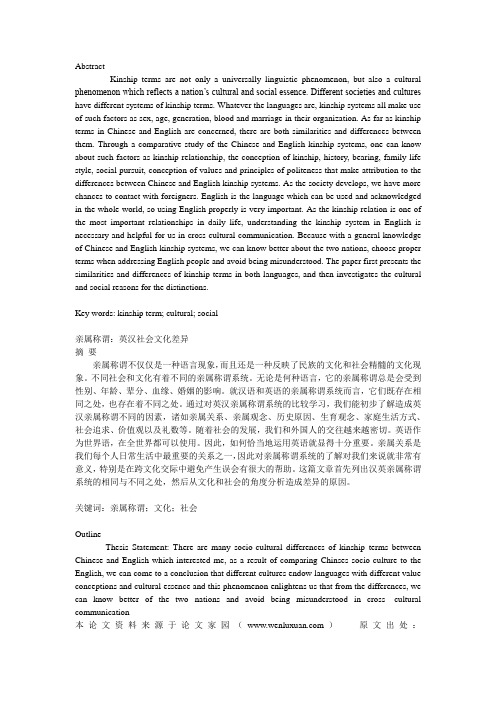
AbstractKinship terms are not only a universally linguistic phenomenon, but also a cultural phenomenon which reflects a nation’s cultural and social essence. Different societies and cultures have different systems of kinship terms. Whatever the languages are, kinship systems all make use of such factors as sex, age, generation, blood and marriage in their organization. As far as kinship terms in Chinese and English are concerned, there are both similarities and differences between them. Through a comparative study of the Chinese and English kinship systems, one can know about such factors as kinship relationship, the conception of kinship, history, bearing, family life style, social pursuit, conception of values and principles of politeness that make attribution to the differences between Chinese and English kinship systems. As the society develops, we have more chances to contact with foreigners. English is the language which can be used and acknowledged in the whole world, so using English properly is very important. As the kinship relation is one of the most important relationships in daily life, understanding the kinship system in English is necessary and helpful for us in cross-cultural communication. Because with a general knowledge of Chinese and English kinship systems, we can know better about the two nations, choose proper terms when addressing English people and avoid being misunderstood. The paper first presents the similarities and differences of kinship terms in both languages, and then investigates the cultural and social reasons for the distinctions.Key words: kinship term; cultural; social亲属称谓:英汉社会文化差异摘要亲属称谓不仅仅是一种语言现象,而且还是一种反映了民族的文化和社会精髓的文化现象。
【最新word论文】英汉亲属称谓的文化差异与互译【外语翻译专业论文】
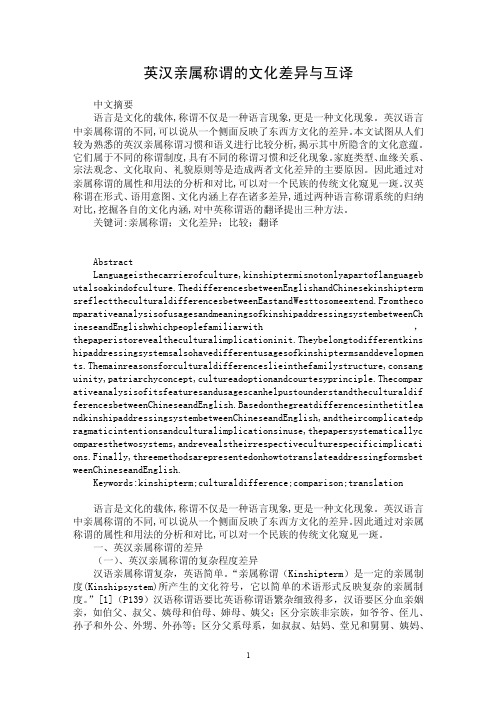
英汉亲属称谓的文化差异与互译中文摘要语言是文化的载体,称谓不仅是一种语言现象,更是一种文化现象。
英汉语言中亲属称谓的不同,可以说从一个侧面反映了东西方文化的差异。
本文试图从人们较为熟悉的英汉亲属称谓习惯和语义进行比较分析,揭示其中所隐含的文化意蕴。
它们属于不同的称谓制度,具有不同的称谓习惯和泛化现象。
家庭类型、血缘关系、宗法观念、文化取向、礼貌原则等是造成两者文化差异的主要原因。
因此通过对亲属称谓的属性和用法的分析和对比,可以对一个民族的传统文化窥见一斑。
汉英称谓在形式、语用意图、文化内涵上存在诸多差异,通过两种语言称谓系统的归纳对比,挖掘各自的文化内涵,对中英称谓语的翻译提出三种方法。
关键词:亲属称谓;文化差异;比较;翻译AbstractLanguageisthecarrierofculture,kinshiptermisnotonlyapartoflanguageb utalsoakindofculture.ThedifferencesbetweenEnglishandChinesekinshipterm sreflecttheculturaldifferencesbetweenEastandWesttosomeextend.Fromtheco mparativeanalysisofusagesandmeaningsofkinshipaddressingsystembetweenCh ineseandEnglishwhichpeoplefamiliarwith,thepaperistorevealtheculturalimplicationinit.Theybelongtodifferentkins hipaddressingsystemsalsohavedifferentusagesofkinshiptermsanddevelopmen ts.Themainreasonsforculturaldifferenceslieinthefamilystructure,consang uinity,patriarchyconcept,cultureadoptionandcourtesyprinciple.Thecompar ativeanalysisofitsfeaturesandusagescanhelpustounderstandtheculturaldif ferencesbetweenChineseandEnglish.Basedonthegreatdifferencesinthetitlea ndkinshipaddressingsystembetweenChineseandEnglish,andtheircomplicatedp ragmaticintentionsandculturalimplicationsinuse,thepapersystematicallyc omparesthetwosystems,andrevealstheirrespectiveculturespecificimplicati ons.Finally,threemethodsarepresentedonhowtotranslateaddressingformsbet weenChineseandEnglish.Keywords:kinshipterm;culturaldifference;comparison;translation语言是文化的载体,称谓不仅是一种语言现象,更是一种文化现象。
英汉称谓语的差异研究
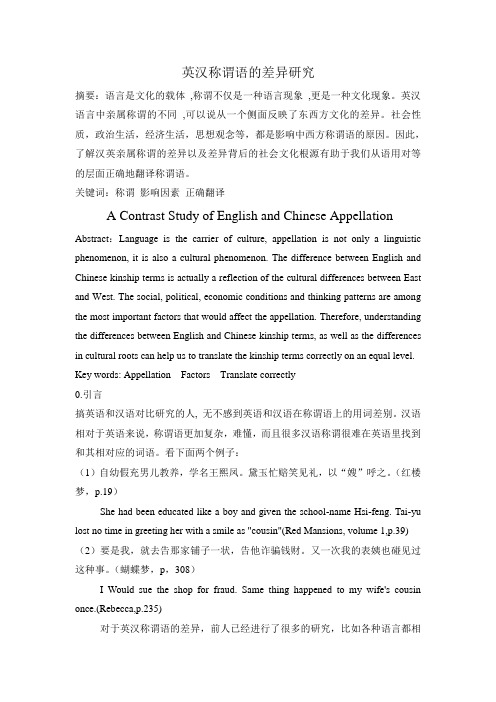
英汉称谓语的差异研究摘要:语言是文化的载体,称谓不仅是一种语言现象,更是一种文化现象。
英汉语言中亲属称谓的不同,可以说从一个侧面反映了东西方文化的差异。
社会性质,政治生活,经济生活,思想观念等,都是影响中西方称谓语的原因。
因此,了解汉英亲属称谓的差异以及差异背后的社会文化根源有助于我们从语用对等的层面正确地翻译称谓语。
关键词:称谓影响因素正确翻译A Contrast Study of English and Chinese Appellation Abstract:Language is the carrier of culture, appellation is not only a linguistic phenomenon, it is also a cultural phenomenon. The difference between English and Chinese kinship terms is actually a reflection of the cultural differences between East and West. The social, political, economic conditions and thinking patterns are among the most important factors that would affect the appellation. Therefore, understanding the differences between English and Chinese kinship terms, as well as the differences in cultural roots can help us to translate the kinship terms correctly on an equal level. Key words: Appellation Factors Translate correctly0.引言搞英语和汉语对比研究的人, 无不感到英语和汉语在称谓语上的用词差别。
英文版中英亲属称谓的简单比较和分析

Eskimo kinship term system, which is a typical example of classification, puts more emphasis on the nuclear family which of only father, mother, son, daughter, brother and sister. It also ignores the distinction between father's side and mother's side.
According to the linking function of human communication, communication is used to establish relationships between the individual and the environment, and that people use symbols to create a desired image to facilitate this linking to the environment. Thus, the individual is consubstantial with society.
中英亲属称谓差异对比分析

2 1年 3 01 月
浙 江 工 贸 职 业 技 术 学 院 学 报
J OURNALOFZHE I JANG NDUS I TRY&T RADE VOC ATI ONAL C L OL EGE
V0. 1 . 1 NO 1 1
M a .011 r2
的亲属称谓 ,例如 ,ft r父亲 ,m te= a e= h o r母亲 ,sn h o=
CHEN Yua — n n ho g
( un nF rs y eh oo i l ol eK n n , u n n 6 02 ) Y n a oet cn l c l g u mig Y n a 5 2 4 rT g aC e
A bs r t act :Bo h En ls n i e e l n u g s h v h i u i u i s i em y t ms T i a e te t o ma e a t g ih a d Ch n s a g a e a e t er n q e k n h p tr s se . h sp p ra t mp s t k
p t r a n tr a, h lo ea i n n e ai n y ma r g ,l e — o n e e ai n a d g n r l ai n o i s i e s ae l d mae n l t e b o d r lt sa d r lt sb ri eed r u g r l t n e e ai t f n h p tr .Th n a o o a y r o z o k m e
以本身为中心上有四代长辈下有四代晚辈形成了高祖曾中英父系与母系的亲属称谓对比世代关系汉语称谓英语称谓父亲的父亲祖父爷爷grandfather母亲的父亲外祖父外公父亲的母亲祖母奶奶grandmother母亲的母亲外祖母外婆儿子的儿子孙子grandson女儿的儿子外孙儿子的女儿孙女granddaughter女儿的女儿外孙女父亲的哥哥伯父父亲的弟弟叔父uncle母亲的兄弟舅舅父亲的姐妹姑母aunt母亲的姐妹姨母父亲兄弟的儿子堂哥弟父亲姐妹的儿子姑表哥弟母亲兄弟的儿子舅表哥弟母亲姐妹的儿子姨表哥弟cousin父亲兄弟的女儿堂姐妹父亲姐妹的女儿姑表姐妹母亲兄弟的女儿舅表姐妹母亲兄弟的女儿姨表姐妹兄弟的儿子侄子姐妹的儿子外甥妻子兄弟姐妹的儿子表侄兄弟的女儿侄女nephew姐妹的女儿外甥女妻子兄弟姐妹的女儿表侄女祖祖父本人子孙曾孙玄孙的九族血亲关系有四个核心词祖父本人子孙
英汉亲属称谓语差异浅析
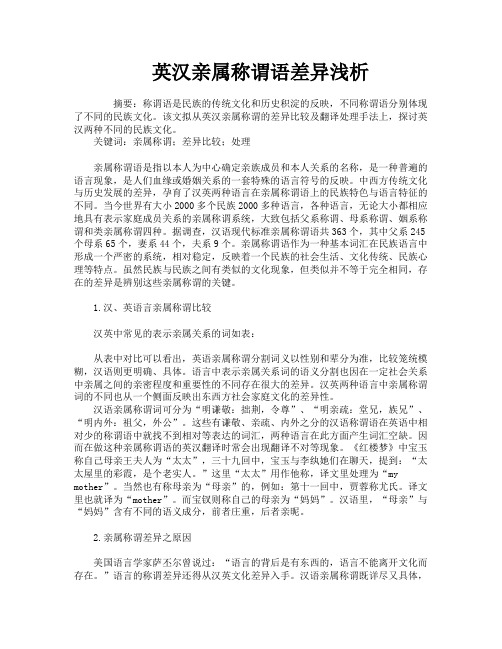
英汉亲属称谓语差异浅析摘要:称谓语是民族的传统文化和历史积淀的反映,不同称谓语分别体现了不同的民族文化。
该文拟从英汉亲属称谓的差异比较及翻译处理手法上,探讨英汉两种不同的民族文化。
关键词:亲属称谓;差异比较;处理亲属称谓语是指以本人为中心确定亲族成员和本人关系的名称,是一种普遍的语言现象,是人们血缘或婚姻关系的一套特殊的语言符号的反映。
中西方传统文化与历史发展的差异,孕育了汉英两种语言在亲属称谓语上的民族特色与语言特征的不同。
当今世界有大小2000多个民族2000多种语言,各种语言,无论大小都相应地具有表示家庭成员关系的亲属称谓系统,大致包括父系称谓、母系称谓、姻系称谓和类亲属称谓四种。
据调查,汉语现代标准亲属称谓语共363个,其中父系245个母系65个,妻系44个,夫系9个。
亲属称谓语作为一种基本词汇在民族语言中形成一个严密的系统,相对稳定,反映着一个民族的社会生活、文化传统、民族心理等特点。
虽然民族与民族之间有类似的文化现象,但类似并不等于完全相同,存在的差异是辨别这些亲属称谓的关键。
1.汉、英语言亲属称谓比较汉英中常见的表示亲属关系的词如表:从表中对比可以看出,英语亲属称谓分割词义以性别和辈分为准,比较笼统模糊,汉语则更明确、具体。
语言中表示亲属关系词的语义分割也因在一定社会关系中亲属之间的亲密程度和重要性的不同存在很大的差异。
汉英两种语言中亲属称谓词的不同也从一个侧面反映出东西方社会家庭文化的差异性。
汉语亲属称谓词可分为“明谦敬:拙荆,令尊”、“明亲疏:堂兄,族兄”、“明内外:祖父,外公”。
这些有谦敬、亲疏、内外之分的汉语称谓语在英语中相对少的称谓语中就找不到相对等表达的词汇,两种语言在此方面产生词汇空缺。
因而在做这种亲属称谓语的英汉翻译时常会出现翻译不对等现象。
《红楼梦》中宝玉称自己母亲王夫人为“太太”,三十九回中,宝玉与李纨她们在聊天,提到:“太太屋里的彩霞,是个老实人。
”这里“太太”用作他称,译文里处理为“my mother”。
中外亲属称谓的差异

表姊 妹
f t e ’ s se ’ d u h a h r S it r S ag— tr ;f ma e c u i e s e l o sn
公公
h s a d’ ah r u b n s fte
女 婿
d u h e ’ o — i— a n lw
分。 如哥 哥 、 姐姐 和弟 弟 、 妹妹 。 而英 语 的
亲 属称 谓 仅 用几 个 词 就 能 全 部 涵盖 。 有 时甚 至连 男女 也不 分 .如 c u i 词可 os n一
可 以称 年轻 的小 男 孩为 sn o 。长 辈对 晚
辈 的称 呼 比较随便 。通 常可 以直呼 其名 ( 用 呢称 ) 多 ,也 可 用 My b y o ,My g i d, My c i ,My c i rn等 称呼语 。 hl d h de l
妈 。sn这个 词 也 具 有 亲属 性 和社 交 性 o
外甥 、 孙 ; 外 区分 父 系母 系 , 叔 叔 、 如 姑
妈、 堂兄 和舅 舅 、 妈 、 兄 ; 姨 表 区分长 幼 辈
两 种 属性 。一 方 面父 母 可 以 直接 用 sn o
称 呼 自己的儿子 ; 一方 面 , 长 的人也 另 年
高祖父
r a a n ft e g e tg e tga d ah r r r
内兄/ 舅子 大
wi S od r b o h r f le rte e’
高祖母
g e tge tga d t e r a a r r n mo r h
女 儿
d u h e a g tr
l ・据I o qh 英 馆 英 ]l tns 语 uEl F b — i
.
中西方称呼语差异

通常使用“爸爸”、“妈妈”或“爹 ”、“娘”等称呼,表示亲昵和尊敬 。
兄弟姐妹间的称呼差异
西方
直呼其名或使用昵称,如“David”或“Emily”。
中国
除了直呼其名外,还可以使用“哥哥”、“姐姐”、“弟弟”或“妹妹”等称 呼,表示亲缘关系。
祖父母与孙子女间的称呼差异
西方
通常使用“Grandpa”或 “Grandma”来称呼祖父母,孙子女 则直呼其名。
VS
中国
在商务场合,通常使用姓氏和职务或行业 职称来称呼对方,例如“刘总”或“赵律 师”。
03
CATALOGUE
中西方对亲戚称呼的差异
对长辈亲戚的称呼差异
中文称呼
在中文中,对于长辈亲戚,我们通常会使用敬语和尊称,如“爷爷”、“奶奶”、“叔叔”、“阿姨”等,以表 达尊敬和亲密。
英文称呼
在英文中,对于长辈亲戚,一般使用“Mr.”、“Mrs.”或“Miss.”加上姓氏来称呼,如“Mr. Smith”、“Mrs. Johnson”等,较少使用亲昵的称呼。
中国
祖父母通常被称为“爷爷”、“奶奶 ”,而孙子女则使用“爷爷”、“奶 奶”来称呼,表示尊敬和亲昵。
02
CATALOGUE
中西方社交场合称呼差异Leabharlann 正式场合的称呼差异西方
在正式场合,通常使用姓氏和头衔来称呼对方,例如“Mr. Smith”或 “Professor Johnson”。
中国
在正式场合,通常使用姓氏和职务来称呼对方,例如“张主任”或“李经理”。
对警察、法官的称呼差异
要点一
总结词
在警察和法官的称呼上,中西方也存在明显的差异。中国 更注重职务和职称,而西方更注重关系和姓名。
英汉亲属称谓差异的分析

英汉亲属称谓差异的分析————————————————————————————————作者:————————————————————————————————日期:英汉亲属称谓差异的分析-英语论文英汉亲属称谓差异的分析王艳莉(松原市前郭县第五中学,吉林松原138000)摘要:亲属称谓主要是以本人为中心确定的亲属成员和本人关系的称呼,主要是通过婚姻关系构成的男女双方血缘关系排列的亲属次序确定的,本文笔者特对此做以下分析。
关键词:英汉亲属;称谓差异;分析中图分类号:G632文献标识码:A文章编号:1005-6351(2012)-06-0052-01 一、英汉亲属称谓亲属称谓主要是以本人为中心确定的亲属成员和本人关系的称呼,主要是通过婚姻关系构成的男女双方血缘关系排列的亲属次序确定的。
[1]比如说爷爷、奶奶、爸爸、妈妈、姐姐、妹妹等等。
在汉语中亲属称谓语规定的十分严密,划分非常详细,辈分排列有序,年龄区分明显。
而英语国家中相对比较简单,划分比较模糊,辈分、年龄的区分意识淡薄,英汉亲属称谓语的不同主要体现如下:(一)专有称谓词和泛指称谓词在汉语亲属称谓中,可以根据不同人关系的远近、年龄的大小、辈分的高低和性别的不同进行了不同了称谓,十分详细,泾渭分明,呈现出专有称谓繁多。
[2]与汉语相反,英语亲属称谓系统明显带有高度的概括性,范围宽泛模糊,呈现出泛指称谓语较多的现象。
在英语亲属称谓系统中,除了father和mother,husband和wife,son和daughter—in—law,daughter和son—in—law,不同于汉语称谓,其他所有称谓语至少有两个外延,比如说“cousin”便有八个外延即堂兄、堂弟、堂姐、堂妹、表兄、表弟、表姐、表妹。
(二)亲属称谓中的性别歧视“男尊女卑”“三从四德”是中国封建社会主要的伦理思想。
[3]男尊女卑观念深入人心,影响久远,在汉语亲属称谓语中,这种观念也有明显具体的反映“男前女后”的组合排序是重男轻女观念制约的结果。
汉英亲属语义场

汉英亲属语义场1. 引言亲属关系在社会交往中起着重要的作用,不同文化背景下对亲属关系的称谓和语义有所差异。
本文将探讨汉英两种语言中的亲属称谓及其语义场,分析它们在不同文化背景下的特点和变化。
2. 汉语亲属称谓及其特点汉语中的亲属称谓较为丰富,涵盖了家庭成员之间的各种关系。
以下是一些常用的汉语亲属称谓:•父母:父亲、母亲、爸爸、妈妈•子女:儿子、女儿•兄弟姐妹:哥哥、弟弟、姐姐、妹妹•祖辈:祖父、祖母、外祖父、外祖母•孙辈:孙子、孙女汉语中的亲属称谓通常直接以血缘关系命名,例如“爸爸”表示自己的父亲,“哥哥”表示自己的兄长。
此外,在不同地区和方言中,亲属称谓还存在一定的差异。
汉语中的亲属称谓还具有年龄和性别的区分。
例如,对于兄弟姐妹中的年纪较大者,通常称为“哥哥”或“姐姐”,而对于年纪较小者,则称为“弟弟”或“妹妹”。
同时,对于父母和祖辈,通常使用“父亲”、“母亲”、“祖父”、“祖母”的正式称谓,而在日常交流中则更常用“爸爸”、“妈妈”等亲昵称呼。
3. 英语亲属称谓及其特点相比汉语,英语中的亲属称谓较为简洁,并且存在一些差异。
以下是一些常用的英语亲属称谓:•父母:父亲(father)、母亲(mother)•子女:儿子(son)、女儿(daughter)•兄弟姐妹:哥哥(brother)、弟弟(brother)、姐姐(sister)、妹妹(sister)•祖辈:祖父(grandfather)、祖母(grandmother)•孙辈:孙子(grandson)、孙女(granddaughter)与汉语不同的是,英语中的亲属称谓并没有年龄和性别的区分。
无论兄弟姐妹中的年纪大小,都使用“brother”或“sister”来称呼。
此外,在英语中还存在一些更加亲昵的称谓,例如“dad”代替“father”,“mom”代替“mother”。
4. 汉英亲属语义场的差异汉英两种语言中的亲属称谓存在一定差异。
首先,汉语中的亲属称谓较为丰富,涵盖了更多种类的亲属关系。
中英称谓语差异
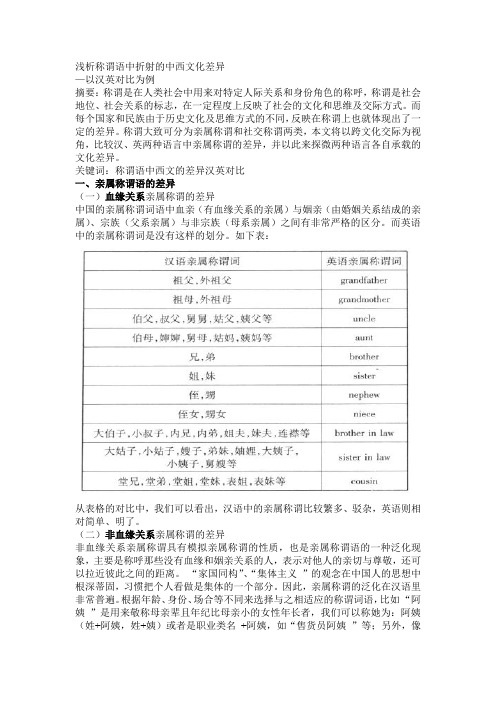
浅析称谓语中折射的中西文化差异—以汉英对比为例摘要:称谓是在人类社会中用来对特定人际关系和身份角色的称呼,称谓是社会地位、社会关系的标志,在一定程度上反映了社会的文化和思维及交际方式。
而每个国家和民族由于历史文化及思维方式的不同,反映在称谓上也就体现出了一定的差异。
称谓大致可分为亲属称谓和社交称谓两类,本文将以跨文化交际为视角,比较汉、英两种语言中亲属称谓的差异,并以此来探微两种语言各自承载的文化差异。
关键词:称谓语中西文的差异汉英对比一、亲属称谓语的差异(一)血缘关系亲属称谓的差异中国的亲属称谓词语中血亲(有血缘关系的亲属)与姻亲(由婚姻关系结成的亲属)、宗族(父系亲属)与非宗族(母系亲属)之间有非常严格的区分。
而英语中的亲属称谓词是没有这样的划分。
如下表:从表格的对比中,我们可以看出,汉语中的亲属称谓比较繁多、驳杂,英语则相对简单、明了。
(二)非血缘关系亲属称谓的差异非血缘关系亲属称谓具有模拟亲属称谓的性质,也是亲属称谓语的一种泛化现象,主要是称呼那些没有血缘和姻亲关系的人,表示对他人的亲切与尊敬,还可以拉近彼此之间的距离。
“家国同构”、“集体主义”的观念在中国人的思想中根深蒂固,习惯把个人看做是集体的一个部分。
因此,亲属称谓的泛化在汉语里非常普遍。
根据年龄、身份、场合等不同来选择与之相适应的称谓词语,比如“阿姨”是用来敬称母亲辈且年纪比母亲小的女性年长者,我们可以称她为:阿姨(姓+阿姨,姓+姨)或者是职业类名+阿姨,如“售货员阿姨”等;另外,像“大爷”、“大叔”、“大姐”、“小妹”这样的词使用得也非常广泛,这些词都非常有助于消除彼此之间的陌生感,使接下去的谈话更加顺畅。
而英语中的亲属称谓泛化现象就远不及汉语的普遍,有些较为传统的家庭可能会将“uncle”和“aunt”来称呼非亲属成员,例如,“aunt Sarah”、“uncle Michael”等;有时一些被大家广泛熟知的称呼被泛指为一类群体,比如“Uncle Tom”就是由于《汤姆叔叔的小屋》(Uncle Tom’s Cabin一书的流传,在近些年已变成了那些被指责投靠白人的非裔国人的绰号。
英汉对比浅析汉语亲属称谓语特点
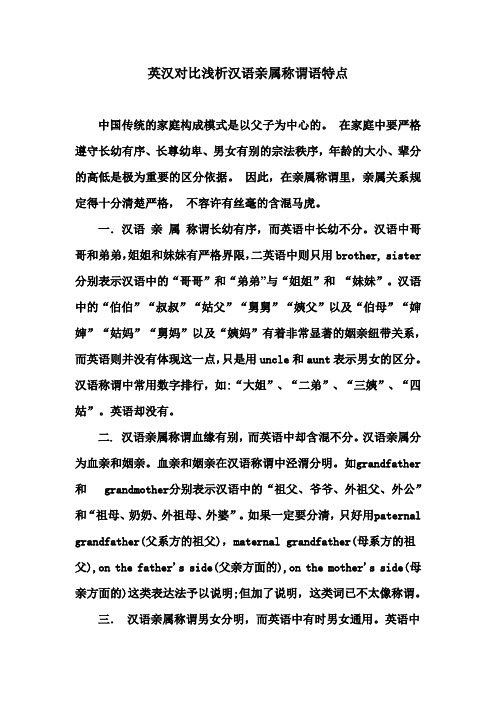
英汉对比浅析汉语亲属称谓语特点中国传统的家庭构成模式是以父子为中心的。
在家庭中要严格遵守长幼有序、长尊幼卑、男女有别的宗法秩序,年龄的大小、辈分的高低是极为重要的区分依据。
因此,在亲属称谓里,亲属关系规定得十分清楚严格,不容许有丝毫的含混马虎。
一.汉语亲属称谓长幼有序,而英语中长幼不分。
汉语中哥哥和弟弟,姐姐和妹妹有严格界限,二英语中则只用brother, sister 分别表示汉语中的“哥哥”和“弟弟”与“姐姐”和“妹妹”。
汉语中的“伯伯”“叔叔”“姑父”“舅舅”“姨父”以及“伯母”“婶婶”“姑妈”“舅妈”以及“姨妈”有着非常显著的姻亲纽带关系,而英语则并没有体现这一点,只是用uncle和aunt表示男女的区分。
汉语称谓中常用数字排行,如:“大姐”、“二弟”、“三姨”、“四姑”。
英语却没有。
二. 汉语亲属称谓血缘有别,而英语中却含混不分。
汉语亲属分为血亲和姻亲。
血亲和姻亲在汉语称谓中泾渭分明。
如grandfather 和 grandmother分别表示汉语中的“祖父、爷爷、外祖父、外公”和“祖母、奶奶、外祖母、外婆”。
如果一定要分清,只好用paternal grandfather(父系方的祖父),maternal grandfather(母系方的祖父),on the father's side(父亲方面的),on the mother's side(母亲方面的)这类表达法予以说明;但加了说明,这类词已不太像称谓。
三.汉语亲属称谓男女分明,而英语中有时男女通用。
英语中对父母亲的兄弟姐妹的子女共同使用一个称谓,即cousin,可表示汉语中的“表哥”、“表弟”、“表姐”、“表妹”、“堂哥”、“堂弟”、“堂姐”、“堂妹”。
四.汉语亲属称谓注重辈分,英语中则辈分淡化。
晚辈对长辈则只能严格按照其相应的称谓来进行称呼,直呼其名是万万不可的。
英语中对父辈甚至祖父辈直呼其名以示亲近。
称谓语实际上是一种具有浓厚民族文化色彩的语言现象,这种语言现象和民族文化相互渗透、相互作用。
汉英语中亲属称谓词的研究
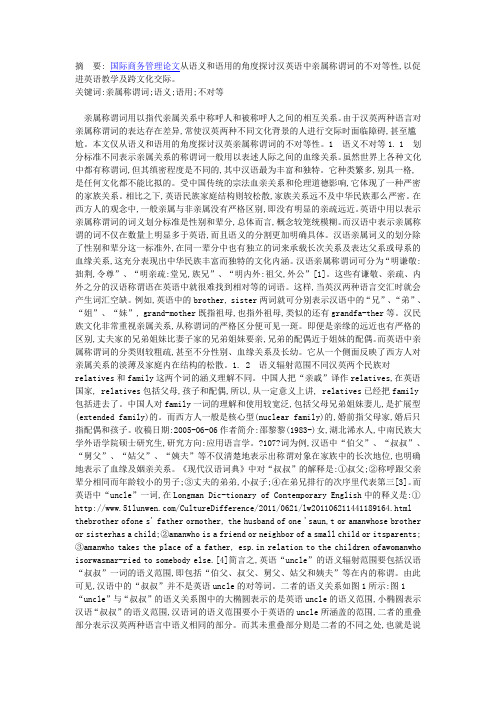
摘要: 国际商务管理论文从语义和语用的角度探讨汉英语中亲属称谓词的不对等性,以促进英语教学及跨文化交际。
关键词:亲属称谓词;语义;语用;不对等亲属称谓词用以指代亲属关系中称呼人和被称呼人之间的相互关系。
由于汉英两种语言对亲属称谓词的表达存在差异,常使汉英两种不同文化背景的人进行交际时面临障碍,甚至尴尬。
本文仅从语义和语用的角度探讨汉英亲属称谓词的不对等性。
1 语义不对等1. 1 划分标准不同表示亲属关系的称谓词一般用以表述人际之间的血缘关系。
虽然世界上各种文化中都有称谓词,但其缜密程度是不同的,其中汉语最为丰富和独特。
它种类繁多,别具一格,是任何文化都不能比拟的。
受中国传统的宗法血亲关系和伦理道德影响,它体现了一种严密的家族关系。
相比之下,英语民族家庭结构则较松散,家族关系远不及中华民族那么严密。
在西方人的观念中,一般亲属与非亲属没有严格区别,即没有明显的亲疏远近。
英语中用以表示亲属称谓词的词义划分标准是性别和辈分,总体而言,概念较笼统模糊。
而汉语中表示亲属称谓的词不仅在数量上明显多于英语,而且语义的分割更加明确具体。
汉语亲属词义的划分除了性别和辈分这一标准外,在同一辈分中也有独立的词来承载长次关系及表达父系或母系的血缘关系,这充分表现出中华民族丰富而独特的文化内涵。
汉语亲属称谓词可分为“明谦敬:拙荆,令尊”、“明亲疏:堂兄,族兄”、“明内外:祖父,外公”[1]。
这些有谦敬、亲疏、内外之分的汉语称谓语在英语中就很难找到相对等的词语。
这样,当英汉两种语言交汇时就会产生词汇空缺。
例如,英语中的brother, sister两词就可分别表示汉语中的“兄”、“弟”、“姐”、“妹”, grand-mother既指祖母,也指外祖母,类似的还有grandfa-ther等。
汉民族文化非常重视亲属关系,从称谓词的严格区分便可见一斑。
即便是亲缘的远近也有严格的区别,丈夫家的兄弟姐妹比妻子家的兄弟姐妹要亲,兄弟的配偶近于姐妹的配偶。
论中英亲属称谓的异同
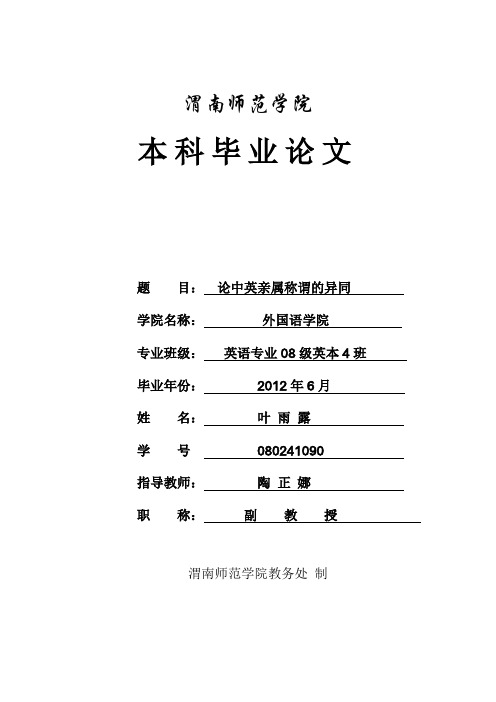
渭南师范学院本科毕业论文题目:论中英亲属称谓的异同学院名称:外国语学院专业班级:英语专业08级英本4班毕业年份:2012年6月姓名:叶雨露学号080241090指导教师:陶正娜职称:副教授渭南师范学院教务处制The Cultural Differences and similarities between Chinese andEnglish Kinship TermsByYang HaiyingA Thesis Presented to School of Foreign Languages ofWeinan Normal Universityas Partial Fulfillment of the Requirementsfor the Degree ofBachelor of ArtsMay 17, 2012Class: Class 4 of 2008Advisor: Guo Zhengxia论中英亲属称谓的异同摘要:语言和文化有着很密切的关系,所以,如果人们要学好一门语言,那么了解其文化是非常重要的。
你理解语言的文化传统、习俗、生活方式以及生活细节越多,你就越能正确地理解并准确地使用这种语言。
称谓语是民族传统文化和历史积淀的反映,不同的称谓语分别体现不同的民族文化。
事实上,文化塑造并影响着语言,同时,语言又反映着文化。
本文主要有三个部分,第一部分主要从相同的功能和相似的分类来阐述中英亲属称谓的相同点。
第二部分主要从旁系关系和直系关系,血亲关系和姻亲关系,父系关系和母系关系,性别,长幼关系和辈分顺序,派生的亲属称谓六个方面来阐述中英亲属关系称谓的不同。
第三部分主要从家庭结构,历史背景,来源等等,来分析中英亲属称谓不同的原因。
关键字:亲属称谓;中英文亲属称谓的对比;文化差异The Cultural Differences and similarities between Chinese andEnglish Kinship TermsAbstract: Language and culture have very close relationship. It is very necessary and important to learn a kind of language well and know the culture well, The more understanding of the language's culture, traditions, customs, lifestyles as well as details of life, the more you can correctly understand and accurately use the language. Kinship terms are reflections of traditional ethnic culture and historical accumulation and different addressing terms respectively embody different ethnic cultures. In fact, language is influenced and shaped by culture, at the same time, language reflects the culture. In this paper, there are three main parts. The first part describes the similarities between English and Chinese kinship terms from two aspects: same functions and similar categories. The second part describes the differences between English and Chinese kinship terms from six aspects: between collateral relations and lineal relations, between blood relation and affined relations, between elder-younger relations and seniority order, between paternal and maternal kinship terms, between gender kinship terms, and derivatives. The third part, from family structures, historical background, sources and other reasons, explains the reasons of the cultural differences between English and Chinese kinship terms.Key words:Kinship terms; Contrast between English and Chinese kinship terms; Cultural differencesTable of ContentsI. Introduction (1)II. Comparison between English and Chinese Kinship Term Systems (1)A. Similarities of English and Chinese kinship terms (2)1. The Same Functions (2)2. Similar Categories (2)B. Differences between English and Chinese kinship terms (3)1. Between collateral relations and lineal relations. (3)2. Between blood relation and affined relations. (5)3. Between paternal and maternal kinship terms (6)4. Gender kinship terms. (7)5. Elder-younger relations and seniority order (7)6.Derivatives of kinship terms (8)III. The reasons of the cultural difference between English and Chinese kinship terms (9)A. Different family structures (9)B. Different historical background (10)C. Different source (11)D. Other reasons (11)IV. Conclusion (12)I. IntroductionLanguage is not only a kind of cultural expression, but also the bridge of communication and kinship terms are indispensable to communication. Kinship term system is a very important part of language expression. Therefore, the kinship terms should be paid more attention. It is impossible to learn English well if you do not understand the British and American cultural background knowledge, especially, the kinship terms. So the different kinship terms between English and Chinese are importance in studying English. And this paper mainly talks about the differences and the similarities between English and Chinese kinship terms, including the reasons of forming these differences.Kinship terms, according to E.R.Leach, are "category words by means of which an individual is taught to recognize the significant groupings in the social structure into which he is born"(1958, P.143). Nowadays, Kinship terms belong to social language and they are used widely in daily communicative life. Therefore, the comparative study of kinship terms in Chinese and English is to understand better different cultural implication and make sure that communication is going on well. So, if we want to learn English, we must pay more attention to kinship terms.In this paper, there are 3 main parts, the first part describes the similarities between English and Chinese kinship term from 2 aspects: same functions and similar categories. The second part describes the differences between English and Chinese kinship terms from 6 aspects: between collateral relations and lineal relations, between blood relation and affined relations, between elder-younger relations and seniority, between paternal and maternal kinship terms, between gender kinship terms, and derivatives. The third part, according to family structures, historical background, sources and other reason to explain the reason of the cultural difference between English and Chinese kinship terms.II. Comparison between English and Chinese Kinship Term Systems There are both similarities and differences between English and Chinese kinship terms; there are not so many limits. They have some similarities in the kinship terms’functions and categories. At the same time, because English and Chinese languages have defined their own set of kinship terms and the roles they serve in the society. There are a lot of differences between English and Chinese kinship terms. English kinship terms are less complicated than Chinese kinship terns. In Chinese, kinship terms are oriented by generation, age, paternal and maternal relationships and in-law relationships. But in England, the way people address others are very random. Then, we will talk the similarities and differences between English and Chinese kinship terms.A. Similarities of English and Chinese kinship termsPeople from different countries have different cultures, but there are many similarities in cultures. Kinship terms must have some similarities in different countries too. It’s necessary to realize the similarities of the kinship terms. It may promote people to get along well with each other. So, the analysis of them is quite important.1. The Same FunctionsEnglish and Chinese kinship term have many important social functions. Generally, no matter English kinship or Chinese kinship terms, they have a basic functions, linking function. according to the linking function of human communication, communication is used to establish relationships between the individual and the environment, and that people use symbols to create a desired image to facilitate this linking to the environment. Thus, the individual is consubstantial with society.2. Similar CategoriesNo matter English kinship terms or Chinese kinship terms, they can be divided into two parts:the kinship terms and the social terms. Kinship system is not only a universal feature of languages, but also a result of the importance in social organization. Social term means the usage of all kinship term strategies and regulations between different social groups and social organizations in their communication according to their social positions and social roles.B. Differences between English and Chinese kinship termsEnglish and Chinese kinship terms stem from two different civilization traditions that have their own evolving history. It is not strange that there are many differences between the two. It is very important to understand these differences, only in this way can avoid many problems in intercultural communications. And then , there 5 key points will be followed.1. Between collateral relations and lineal relations.In Chinese kinship terms, there is some difference between collateral relations and lineal relations, but in English kinship terms, there is little difference. First, please look at the following 2 tables; they will help us to understand the differences between collateral relations and lineal relations.Table 1 Lineal relationsRelation Chinese Terms English Termspaternal grandfather maternal grandfatherzu fu(祖父)wai zu fu(外祖父)grandfatherpaternal grandfather maternal grandfatherzu mu(祖母)wai zu mu(外祖母)grandmotherfather fu qin(父亲)father mother mu qin(母亲)motherelder brother younger brother ge ge(哥哥)di di (弟弟)brotherelder sister younger sisterjie jie(姐姐)mei mei(妹妹)sisterson er zi(儿子)son daughter nv er(女儿)daughterson's son daughter's sonsun zi(孙子)wai sun(外孙)grandsonson's daughter daughter's daughtersun nv(孙女)wai sun nv(外孙女)granddaughterThe above table talks about the lineal relations kinship terms, from table 1, we can see that the English language pays little attention to consanguinity and affinity relations in its kinship terms. But the Chinese language considers that these are important. And in China, there is another relation, who is collateral relations; therefore, the following table is to talk about it.Table 2 Collateral relationsRelations Chinese Terms English Termsfather's elder brother father's younger brother mother's brother bo fu(伯父)shu fu(叔父)jiu fu(舅父)unclefather's sister mother's sister gu mu(姑妈)yi mu(姨妈)auntfather's brother's sonfather's sister's son mother's brother's sonmother's sister's son father's brother's daughter father's sister's daughter mother's brother's daughter mother's sister's daughtertang ge/di(堂哥/弟)gu biao ge/di(姑表哥/弟)jiu biao ge/di(舅表哥/弟)yi biao ge/di(姨表哥/弟)tang jie/mei(堂姐/妹)gu biao jie/mei(姑表姐/妹)jiu biao jie/mei(舅表姐/妹)yi biao jie/mei(姨表姐/妹)cousinBrother’s sonSister’s son Wife’s sibling’s sonzhi zi(侄子)wai sheng(外甥)biao zhi(表侄)nephewbrother’s daughtersister’s daughter wife’s sibling’s daughterzhi nv(侄女)wai sheng nv(外甥女)biao zhi nv(表侄女)nieceThe above box talks about collateral relations. From the table, we know that many differences between Chinese and English in collateral relations. For example, when a boy says this is my uncle. In fact, we can’t get the informationonly from the word those words, but in Chinese, we can know much information, such as sex, birth order and so on.2. Between blood relation and affined relations.About the blood relation and relations by marriage, these people are called relations with blood; and those are called relation by marriage. In Chinese, their kinship terms are different and are very clear. In paternal clan, bo fu, shu fu, jiu fu, gu mu,and yi mu belong to blood relation; Gu fu, yi fu, bo mu, shen mu,and jiu mu, belong to relations by marriage. At the same time, it reflects that Chinese have strong clan relative sense.But in English, there is no classification between blood relation and relations by marriage. There being an example is the kinship term uncle. According to Ullmann (1962), the English word "uncle" comes via French from the Latin avunculus, which meant onl y one kind of uncle, namely, the mother’s brother, whereas the father’s brother was called patruus. Since the latter word fell into disuse, the descendants of avunculus have come to stand for both kinds of uncle, so that the range of the Latin term has been doubled (p. 228).In the OXFORD ADV ANCED LEARNER’S English-Chinese Dictionary, the word, uncle,is explained: 1. the brother of one's father; 2. the brother of one's mother; 3. the husband of one's aunt (p.1915). And the same, aunt is explained: 1. a sister of one's mother; 2. a sister of one's father; 3. the wife of one's uncle (p.95). So, based on the above examples, uncle includes parents' brothers and parents' sisters' husbands, for example, gu fu, shu fu, jiu fu, gu zhang and y i zhang; aunt means parents' sisters and parents' brothers' wives, such as gu mu, yi mu, bo mu, shen mu and jiu mu.Of course, English does not ignore relations by marriage, in English, there often has a suffix in-laws followed by some kinship terms of blood relation, for instance, brother-in-laws ,this word means jie fu, mei fu, husbands' jie fu , husbands' mei fu, nei xiong, nei di, da bo zi and xiao shu zi.There is a table to show the affined relations:Table 3 Affined relationsRelation Chinese Term English Term wife's/husband's father yue fu /gong gong(岳父/公公)father-in-law wife's/husband's mother yue mu/po po(岳母/婆婆)mother-in-lawfather's sister's husband mother's sister's husband gu fu(姑父)yi fu(姨夫)unclefather's elder brother's wife father's younger brother's wife mother's brother's wife bo mu(伯母)shen mu(婶母)jiu mu(舅母)auntwife/husband qi zi/zhang fu(妻子丈夫)wife/husbandelder sister's husband younger sister's husband husband'selder/younger brotherwife's brother jie fu(姐夫)mei fu(妹夫)da bo/xiao shu(大/伯小叔)da/xiao jiu zi(大/小舅子)brother-in-lawelder brother's wife younger brother's wife wife's elder/younger sister brother's wife sao zi(嫂子)di xi(弟媳)da/xiao yi zi(大/小姨子)zhou li(妯娌)sister-in-lawson's wife er xi(儿媳)daughter-in-law daughter husband nv xu(女婿)son-in-law The above box talks about affined relations, just like the second box, in English, just several kinship terms can express more in Chinese.3. Between paternal and maternal kinship termsIn contrast to English kinship terms, the Chinese kinship system is more complicated. There are many differences in paternal and maternal kinship terms.Chinese kinship emphasizes paternal kinship, while English is not. Chinese people attach much importance to consanguineous relations rather than affined relations which connotes by kinship terms apparently. The difference between "close" and "distant" is taken seriously in Chinese culture. Paternal lineages are more "close" thanmaternal ones. Usually, paternal lineages is labeled "tang", such as"tang ge/ di", "father’s brother’s so n, while maternal lineages is labe1ed"biao",such as "biao ge/di "(mother’s brother’s son). In Chinese kinship system, affined relations, i.e. in-laws, 0uses of your siblings) have their own specific titles, such as father’s elder brother’s wife is called "bo mu",younger sister’s husband is called"meifu", and so on. In English, maternal and paternal lineages, consanguineous and affined relations are not distinguished so distinctly. We even can not distinguish an "uncle" whether is one’s father’s brother or one’s mother’s brother.4. Gender kinship terms.The gender of the relative is distinguished in Chinese culture, while not in English. In Chinese culture,the gender of the relative is distinguished distinctly. For example, title for "father’s brother’s son" is strictly distinguished from that for "father’s brother’s daughter". English kinship system may ignore the sex distinction.For example,all male and female children of a person’s father/mother’s brother/sister can be called "cousin". It may refer to the mother’s brother’s son, mother’s brother’s daughter, mother’s sister’s son, mother’s sister’s daughter,father’s brother’s son, father’s brother’s daughter,father’s sister’s son, father’s sister’s daughter, and so on. Meticulous Chinese kinship system has its roots deep in Chinese culture. It is the product of an agricultural society, a family-centered economy, and a hierarchical family system. Likewise,English kinship system also origins from its own culture. Simple nuclear family, independence of individuals, friendship extended to non—kinship all these factors result in the straightforward English kinship system.5. Elder-younger relations and seniority orderTraditional Chinese society is organized in vertical structure, and has always advocated family and lives for generations under one roof. Chinese culture lays stress on ”superior controls junior” , in the family, people should respect for seniority, the descendant is not allowed to call the elderly by name, and seniority is extremely important to the level of scale. Therefore, in kinship terms words, the same seniority in the family distinguishes from ge ge and di di, jie jie and mei mei,bo fu and shu fu, bo mu and shen mu. In the different seniority, as to the higher seniority, they can callothers who are lower seniority with their full names, including the last name. However, oppositely, the lower seniority can not call the higher seniority with name, it will shows that they are not polite. The kind of idea has rooted in Chinese mind. These older people's kinship terms are sacred title.However, in English, there is no difference in seniority, and the higher seniority is not important, the descendant and the elderly relate as friends, the descendant is allowed to call the elderly by name. In the western culture, old age is not advantaged. So, in English, we can know that “brother”includes the elder and the younger one, “sister” applied to elder sister and younger sister are both feasible. and there are many word like that, such as, uncle and aunt. Besides, in western country, people usually call families with names or even nick names. For example, in Family Album, U.S.A, the daughter-in-law Marilyn calls her father-in-law Philip with name.(Episode 6,Act Ш).So, in their mind, it will show that they are much closer. The following dialog is taken from Family Album, U.S.A:1.Ellen:Where are you going,Philip?Philip:Remember,the Michigan football game?And Michigan needs a touchdown.Ellen:Did you forget something?Robbie:Dad,your famous apple pie.Philip:Just let me see the score,Ellen.Marilyn:Go ahead,Philip.We should all take a little breakbefore dessert.2.Ellen:Robbie,would you bring the dessert plates.And,Marilyn,would you pour coffee,please.Marilyn:Sure,Ellen.6.Derivatives of kinship termsChinese is an analyzing language, the grammar relationship among words is expressed by some other words, and the formation of those words is stable. Therefore, in Chinese, there is no some derivatives expressing “love”. If we need to express love, we can add some words to the front of some kinship term. For example, A ba, A jiu, Amei, hao mama, guai er zi, qin ai de baba,or other words, mei zi, shen er and some kinship terms from Hong Kong and Tai Wan, lao ba, lao ma.And some are from Europe or America, just like ma mi, ba bi, and so on.But English belongs to comprehensive language, it has own character that the grammar relationship among words is expressed by those words own changing. So, generally, they often add to some suffixes. For instance, mum-mummy, mom-mommy; dad-daddy, dadie; grandpa-grandpop, gramp; grandma-grandmama; granny-grannie; nan-nany, nana; daughter-daughtie; son-sonny; aunt-auntie, aunty and so on.III. The reasons of the cultural difference between English and Chinese kinship termsEnglish and Chinese address forms originated from two different civilization traditions that have their own evolving history. It is not strange that there are many differences between the two. The main reasons for cultural differences lie in the family structures, history background, source and so on.A. Different family structuresMany cultural differences exist in family structures and values. On one hand,, i t’s well- known that ancient China was a feudal agricultural country. People lived on tilling the land and settled in those places with rich soil. In this case, self-supporting natural economy gradually took shape. However, people had to labor together and had a collective life owing to the low productivity. So, they lived together and formed an extended family, gradually, the dominant type of family is extended family. An extended family means a family is made up of two or more adult generations, and these generations of the family sharing a common household and economic resource. Therefore, there are complex relations between family members. In addition, in China, the position in the family hierarchy is distinguished clearly. It has a strict distinction between blood relative and affined relative, clan and non-clan, and also personal status, right, obligation, behavior, therefore, in China, a detailed and clear division in kinship terms is necessary. According to generation, age and sex, people were required to address and distinguish different family members.On the other hand, in the west, there is no extended family, but a nuclear family. With the advent of the Industrial Revolution period, manpower in Anglo-American countries was no longer the important factor in the process of working. Therefore, an increasing number of nuclear families began to form and played a leading role in the current society. A nuclear family means a family consisting of parents and their unmarried children, and they live far away from other relatives. Generally speaking, a nuclear family has very few members, only parents and offspring. In western countries, because people usually hold the view that they should live a independent life, they are willing not to live with their parents after they get married, they believe in self-reliance and freedom. Furthermore, aged people prefer to live in the nursery home rather than live with their children. As a result, the parents and their children also have their own families, which can avoid conflicts between parents and children brought about by the generation gap.So the nuclear family is simpler. It is no wonder that the English kinship terms is more simple than Chinese.B. Different historical backgroundAs we all know, feudal patriarchal society controlled China for two thousand years, influenced by the moral and ethical concepts; Chinese must chose suitable terms to address others according to the rank and identity. In addition, Chinese people value the close family relationship and prefer living together with or near their families. This is greatly influenced by China's great teacher and philosopher Confucius, who educated his people not to study or work far away from home while their parents were still alive. This concept has since become one of the traditions of Chinese culture. Because of this concept of close family ties, Chinese families are usually very large. Since people prefer living with or near their families, family members encounter each other frequently in daily routine;therefore, it is convenient for them to keep those precise kinship terms. It is no doubt that the patriarchal clan system produced a great impact on Chinese culture, including the kinship term system.On the contrary, in the west, people think equality is very important. They hold the view that all men are born equal. In western families, all members are in an equalstatus. Thus, father and mother, husband and wife, son and daughter and the siblings are in the same status respectively. They are prone to address others by names regardless of the rank and identity. This phenomenon expresses intensely their hope of getting rid of differences in social status. Therefore, English kinship terms give expression to equality in personality, especially for addressing relatives on father’s side or mother’s side.C. Different sourceChinese kinship terms belong to Sudanese kinship system, but English kinship terms are Eskimo kinship system. Sudanese kinship system is descriptive system, which makes a clear distinction between maternal and paternal relatives. It is so highly descriptive and detailed that generally every relative is named by a different kinship term. What’s more, there is an inclination to relatives of paternal side as well as of lineal relationships because of the male people in paternal side and consanguineous relatives having been put more emphasis. Eskimo kinship term system, which is a typical example of classification, puts more emphasis on the nuclear family which of only father, mother, son, daughter, brother and sister. It also ignores the distinction between father’s side and mother’s side, which shows that it is bilateral.D. Other reasonsFrom a cultural point of view of origin, the environments of China and Western countries are different, which has made those people choose different methods to adapt to the environment, therefore, different cultures were formed. In West, the development of material changes in production methods, social and political changes in the economic development, but also influence and determine the changes in cultural development.Europe’s geographic structure formats the Western culture the survival of the state of coexistence with the sea, seafaring and the Industrial Revolution developed, so that from the very early development of commercial economy, which created the mankind's oldest commercial civilization. However, China is a traditional agricultural country, after one thousands of years developing, China has developed as an agricultural civilization. So it is different from theEuropean countriesSo China and the European countries produced different civilization and culture, and it was reflected by language, especially in kinship terms. Therefore, there are some different points between Chinese and English kinship terms.IV. ConclusionSo, based on the above statements, kinship term, an indispensable part of verbal communication, is clearly highlighted in address system of a language. Although English and Chinese languages share a few semantic constants in common, however, kinship terms of these two languages can not be fully translated equivalently. In this paper, the authors illustrate the similarities differences between English an d Chinese kinship terms and reveal the causes it results from. In contrast: English address forms are less complicated than Chinese address forms, with Chinese kinship terms, it will help us better understand English kinship system and their cultures, which will also help us improve cross-cultural communication and thus conduct the further studies in this field.BibliographyHu Wen, Hu Min. Comparative study on English and Chinese kinship terms.US-China Foreign Language Press,2007Leach E. R. Concerning trobriand clans and the kinship category "tabu." In J.Goody (ed.), the developmental cycle in domestic groups. Cambridge:Cambridge University Press,1958:120~145The OXFORD ADVANCED LEARNER’S English-Chinese Dictionary. Oxford University Press,2006Ullmann, S. Semantics: An introduction to the science of meaning. Oxford: Basil Black Well, 1962刘承华. 《文化与人格——对中西文化差异的一次比较》. 中国科学技术大学出版社. 2002:79王守仁, 何宁. 《新编英语口语教程》.上海: 上海外语教育出版社1998(9):黎昌抱. “英汉亲属称谓词国俗差异研究”《四川外语学院报》. 2001(2):卢卫中. “英汉呼语探讨外语研究” 1992(4):48~51胡怡亭. 《英汉思维模式差异研本英语论文》2004:6。
中西方亲属称谓对比
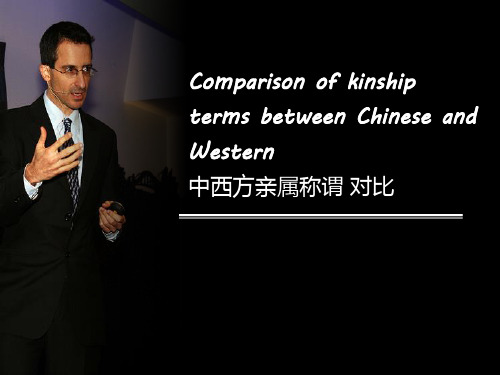
在中国传统文化体系中占 主导地位的孔孟儒学,其 伦理道德说教均以宗法性 家庭及血缘纽带为宗旨, 受“长幼有序、男女有别、 内外有别、亲疏有别、血 亲姻亲有别”的传统伦理 规范的影响,汉语言中的 亲属称谓体系特别强调等 级的差异,提倡长幼、尊卑 有序。
儒学文化
特别是男尊女卑的典型例证:“外 祖父/外祖母”(母亲的父母)和 “外孙/外孙女”(女儿的子女)有 别于“祖父/祖母”(父亲的父母) 和“孙子/孙女”(儿子的子女)。 一个“外”字折射出男性在家庭中 的主导地位,而女性是外人,处于 从属地位。
以父系为中心的宗法制社会 重名分、讲人伦的儒家文化 中国人集体主义的价值观
在家族和血缘关系基础上建立的君主 制的宗法制社会,其实是一个“差序 格局”的等级社会,这样的社会以维 护上尊下卑的秩序为根本,是个不平 等的社会,即使是同一家庭里的人也 是不平等的。
Comparison of kinship terms between Chinese and Western 中西方亲属称谓 对比
亲属称谓
亲属称谓是指用于有亲属关系的人之间的称谓。
法律上对亲属范围的界定只限于直系血亲和三代以内的旁系血亲,那些诸如 干爹干妈之类的不在我们讨论的范围之内。
Click to add
• There is no difference in the name of your family members between father’s side and mother’s side in English.
Parents
当下贾母一一指与黛玉:“这是你大舅母; 这是你二舅母.”
“This ,” she said , “ is your __e_l_d_e_r _u_n_c_le_’s wife . This is your __s_e_c_o_n_d_u_n_c_le_’s wife .”
汉英亲属称谓研究论文
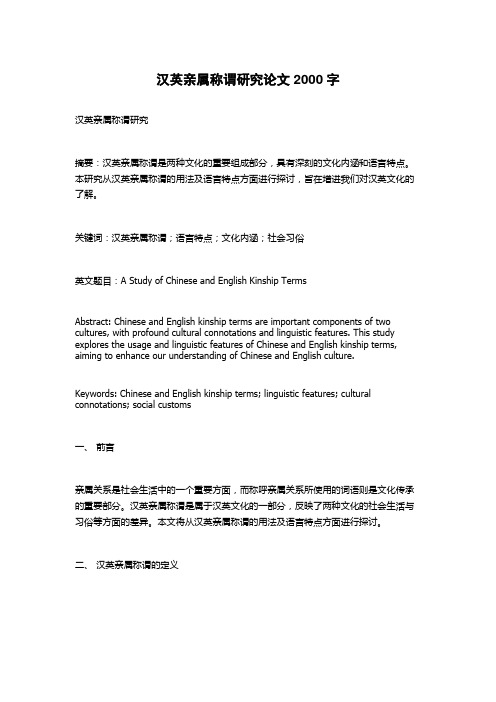
汉英亲属称谓研究论文2000字汉英亲属称谓研究摘要:汉英亲属称谓是两种文化的重要组成部分,具有深刻的文化内涵和语言特点。
本研究从汉英亲属称谓的用法及语言特点方面进行探讨,旨在增进我们对汉英文化的了解。
关键词:汉英亲属称谓;语言特点;文化内涵;社会习俗英文题目:A Study of Chinese and English Kinship TermsAbstract: Chinese and English kinship terms are important components of two cultures, with profound cultural connotations and linguistic features. This study explores the usage and linguistic features of Chinese and English kinship terms, aiming to enhance our understanding of Chinese and English culture.Keywords: Chinese and English kinship terms; linguistic features; cultural connotations; social customs一、前言亲属关系是社会生活中的一个重要方面,而称呼亲属关系所使用的词语则是文化传承的重要部分。
汉英亲属称谓是属于汉英文化的一部分,反映了两种文化的社会生活与习俗等方面的差异。
本文将从汉英亲属称谓的用法及语言特点方面进行探讨。
二、汉英亲属称谓的定义亲属关系是人际关系中非常重要的一类关系,在不同的地区、不同的文化背景下,其名称、称谓均不尽相同。
汉英亲属称谓是指中英两种文化中,表示亲属关系的称呼,包括亲属的血缘和婚姻关系等。
三、汉英亲属称谓的用法汉英亲属称谓的使用体现了不同的文化概念和社会习俗。
- 1、下载文档前请自行甄别文档内容的完整性,平台不提供额外的编辑、内容补充、找答案等附加服务。
- 2、"仅部分预览"的文档,不可在线预览部分如存在完整性等问题,可反馈申请退款(可完整预览的文档不适用该条件!)。
- 3、如文档侵犯您的权益,请联系客服反馈,我们会尽快为您处理(人工客服工作时间:9:00-18:30)。
矿产资源开发利用方案编写内容要求及审查大纲
矿产资源开发利用方案编写内容要求及《矿产资源开发利用方案》审查大纲一、概述
㈠矿区位置、隶属关系和企业性质。
如为改扩建矿山, 应说明矿山现状、
特点及存在的主要问题。
㈡编制依据
(1简述项目前期工作进展情况及与有关方面对项目的意向性协议情况。
(2 列出开发利用方案编制所依据的主要基础性资料的名称。
如经储量管理部门认定的矿区地质勘探报告、选矿试验报告、加工利用试验报告、工程地质初评资料、矿区水文资料和供水资料等。
对改、扩建矿山应有生产实际资料, 如矿山总平面现状图、矿床开拓系统图、采场现状图和主要采选设备清单等。
二、矿产品需求现状和预测
㈠该矿产在国内需求情况和市场供应情况
1、矿产品现状及加工利用趋向。
2、国内近、远期的需求量及主要销向预测。
㈡产品价格分析
1、国内矿产品价格现状。
2、矿产品价格稳定性及变化趋势。
三、矿产资源概况
㈠矿区总体概况
1、矿区总体规划情况。
2、矿区矿产资源概况。
3、该设计与矿区总体开发的关系。
㈡该设计项目的资源概况
1、矿床地质及构造特征。
2、矿床开采技术条件及水文地质条件。
